-
24
Jun
Axel Geijsel (Tilburg University – The Netherlands), Rodolfo Cortes Barragan (Stanford University – U.S.A.)
June 7, 2016
“You can fool some of the people all of the time, and all of the people some of the time, but you cannot fool all of the people all of the time.” Abraham Lincoln
“No one has yet figured out a straightforward method of ensuring that one of the most revered democratic institutions – in this case, electing a U.S. president – can be double checked for fraud, particularly when paperless evoting systems are used.” Larry Greenemeier, Scientific American
Summary Statement
Given the stakes in the outcome of the American presidential elections, ensuring the integrity of the electoral process is of the utmost importance. Are the results we are witnessing in the 2016 primary elections trustworthy? While Donald Trump enjoyed a clear and early edge over his Republican rivals, the Democratic contest between former Secretary of State Hillary Clinton and Senator Bernard Sanders has been far more competitive. At present, Secretary Clinton enjoys an apparent advantage over Sanders. Is this claimed advantage legitimate? We contend that it is not, and suggest an explanation for the advantage: States that are at risk for election fraud in 2016 systematically and overwhelmingly favor Secretary Clinton. We provide converging evidence for this claim.
First, we show that it is possible to detect irregularities in the 2016 Democratic Primaries by comparing the states that have hard paper evidence of all the placed votes to states that do not have this hard paper evidence. Second, we compare the final results in 2016 to the discrepant exit polls. Furthermore, we show that no such irregularities occurred in the 2008 competitive election cycle involving Secretary Clinton against President Obama. As such, we find that in states wherein voting fraud has the highest potential to occur, systematic efforts may have taken place to provide Secretary Clinton with an exaggerated margin of support.
Different outcomes in primary states with paper trails and without paper trails Data procurement: Given the potential that the underlying voting number has been corrupted, we had to restrict our analysis to a proxy: the percentage of delegates won by Secretary Clinton and Senator Sanders. To group states according to the accountability of the vote, we used Ballotpedia and created two groups. First, there are 18 states that feature voting procedures wherein the accuracy of electoral results of a primary ballot vote are backed by a paper trail. Second, there are 13 states that do not have such a paper trail.
Analysis: The [data] show a statistically significant difference between the groups. States without paper trails yielded higher support for Secretary Clinton, (M no paper trail = 65.13%, SD = no paper trail = 10.41%) than states with paper trails (M paper trail = 48.53%, SD = paper trail = 16.00%), t(29) = 3.21, P = 0.003, d = 1.19 [Figure 1]. As such, the potential for election fraud in voting procedures is strongly related to enhanced electoral outcomes for Secretary Clinton. In the Appendix, we show that this relationship holds even above and beyond alternative explanations, including the prevailing political ideology and the changes in support over time.
Supplemental analysis on caucus states: Does the pattern seen in ballot states occur in caucus states? By the very nature of caucusing procedures, caucus results are generally thought to be more trustworthy. However, in the current Democratic caucusing cycle, Iowa and Nevada had caucuses widely alleged to have involved a considerable level of voter suppression and potential fraud. We examined the [data] and found that these two states had far higher support for Secretary Clinton, [M fraud allegations = 54.71%, SD = fraud allegation = 3.44%] than the other caucus states, [M no fraud allegations = 31.61%, SD = no fraud allegations = 9.98%], t independentmeans (11) = 3.13, P = 0.009, d = 3.10.
Anomalies exist between exit polls and final results
Data procurement: We obtained exit poll data from a database kept by an expert on the American elections.
Analysis: On the overall, are the exit polls different from the final results? Yes they are. The data show lower support for Secretary Clinton in exit polls than the final results would suggest, [M exit = 54.38%, SD = exit = 13.95%; M final = 57.52%, SD = final = 13.87%], t dependentmeans (23) = 3.49, P = 0.002, d = 0.71. While an effect size of 0.71 is quite substantial, and suggests a considerable difference between exit polls and outcomes, we expected that this difference would be even more exaggerated in states without paper voting trails. Indeed, the effect size in states without paper voting trails is considerably larger: 1.50, and yields more exaggerated support for the Secretary in the hours following the exit polls [M exit = 62.93%, SD = exit = 8.80%; M final = 65.68%, SD = final = 9.52%], t dependentmeans (9) = 4.68, P < 0.001. In contrast, the effect size is much smaller in states with paper trails, [M exit = 48.28%, SD = exit = 13.94%; M final = 51.69%, SD = final = 13.77%], t dependentmeans (13) = 2.27, P = 0.04, d = 0.58.
Irregularities are unique to 2016
To show that the pattern of votes may suggest a systematic effort to undercut Senator Sanders, we must show that no such patterns were in place in similar elections. Given that Secretary Clinton lost to President Obama in 2008, their data is a natural control and the best possible point of comparison for the 2016 data. Thus, as we did for 2016, we tabulated the percentage of delegates won in each state by (then Senator) Hillary Clinton. The data show that, contrary to the 2016 data, there is no evidence that primary states without paper trails favored Senator Clinton in 2008, P = 0.38. As such, the patterns of 2016 are different from their best point of comparison.
Conclusion
Are we witnessing a dishonest election? Our first analysis showed that states wherein the voting outcomes are difficult to verify show far greater support for Secretary Clinton. Second, our examination of exit polling suggested large differences between the respondents that took the exit polls and the claimed voters in the final tally. Beyond these points, these irregular patterns of results did not exist in 2008. As such, as a whole, these data suggest that election fraud is occurring in the 2016 Democratic Party Presidential Primary election. This fraud has overwhelmingly benefited Secretary Clinton at the expense of Senator Sanders.
















